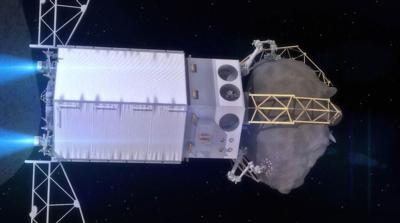RFI Issued Seeking Ideas From American Companies For Spacecraft Design
NASA has issued a Request for Information (RFI) seeking ideas from American companies for a spacecraft design that could be used for both the agency's Asteroid Redirect Mission (ARM) and a robotic satellite servicing mission in low-Earth orbit.

In the early-2020s NASA plans to launch the Asteroid Redirect Mission, which will use a robotic spacecraft to capture a large boulder from the surface of a near-Earth asteroid and move it into a stable orbit around the moon for exploration by astronauts, all in support of advancing the nation's journey to Mars.
NASA also has been studying the "Restore-L" mission concept, during which a spacecraft would use dexterous robotic systems to grapple and refuel a government satellite in low-Earth orbit. Restore-L would bring to operational status capabilities needed for future commercial satellite servicing by demonstrating technologies and reducing risk.
"Today's call for ideas from our industry partners is another important milestone for the Asteroid Redirect Mission, a critical capability demonstration mission that's part of our stepping stone approach for sending American astronauts to Mars in the 2030s," said NASA Associate Administrator Robert Lightfoot. "As part of our acquisition strategy, we're asking for more information toward the ARM spacecraft concept and also on commonality with a notional robotic satellite servicing spacecraft."
The RFI is not a request for proposal or formal procurement and therefore is not a solicitation or commitment by the government. Deadline for submissions is 45 days after public posting of the RFI.
Following its rendezvous and touchdown with the target asteroid, the uncrewed ARM spacecraft will deploy robotic arms to capture a large boulder from its surface. It then will begin a multi-year journey to redirect the boulder into orbit around the moon.
Throughout its mission, the ARM robotic spacecraft will test a number of capabilities needed for future human missions, including advanced Solar Electric Propulsion (SEP), a valuable capability that converts sunlight to electrical power through solar arrays and then uses the resulting power to propel charged atoms to move a spacecraft. This method of propulsion can move massive cargo very efficiently. While slower than conventional chemical rocket propulsion, SEP-powered spacecraft require significantly less propellant and fewer launches to support human exploration missions, which could reduce costs.

This RFI seeks spacecraft designs that may include taking advantage of Xenon capacity SEP, single or multiple component architectures and cost-sharing partnerships.
Future SEP-powered spacecraft could pre-position cargo or vehicles for future human missions into deep space, either awaiting crews at Mars or staged around the moon as a waypoint for expeditions to the Red Planet.
ARM's SEP-powered robotic spacecraft will test new trajectory and navigation techniques in deep space, working with the moon's gravity to place the asteroid in a stable lunar orbit called a distant retrograde orbit. This location is a suitable staging point for astronauts to rendezvous with a deep space habitat that will carry them to Mars.
Before the large asteroid boulder is moved to lunar orbit, NASA will use the opportunity to test planetary defense techniques to inform mitigation of potential asteroid impact threats in the future. The experience and knowledge acquired through this operation will help NASA develop options to move an asteroid off an Earth-impacting course, if and when that becomes necessary.
NASA's Near Earth Objects Program continues to implement new capabilities and upgrades to existing projects for detecting and cataloging asteroids. The agency also has engaged non-traditional partners and the public in the hunt for undetected asteroids through the NASA's Asteroid Grand Challenge activities, including prize competitions. In March, the agency announced the release of a software application based on an algorithm created through a NASA challenge that has the potential to help increase the number of asteroid detections in collected sky images.
(Image provided by NASA)
 ANN's Daily Aero-Term (04.26.24): DETRESFA (Distress Phrase)
ANN's Daily Aero-Term (04.26.24): DETRESFA (Distress Phrase) ANN's Daily Aero-Linx (04.26.24)
ANN's Daily Aero-Linx (04.26.24) Airborne 04.22.24: Rotor X Worsens, Airport Fees 4 FNB?, USMC Drone Pilot
Airborne 04.22.24: Rotor X Worsens, Airport Fees 4 FNB?, USMC Drone Pilot Airborne 04.24.24: INTEGRAL E, Elixir USA, M700 RVSM
Airborne 04.24.24: INTEGRAL E, Elixir USA, M700 RVSM Airborne-NextGen 04.23.24: UAVOS UVH 170, magni650 Engine, World eVTOL Directory
Airborne-NextGen 04.23.24: UAVOS UVH 170, magni650 Engine, World eVTOL Directory




